®
Mil Mi-24 V Hind E
04839-0389 ©2013 BY REVELL GmbH. A subsidiary of Hobbico, Inc. PRINTED IN GERMANY
Mil Mi-24 V Hind E Mil Mi-24 V Hind E
Der Mi-24V ist ein russischer Schlachthubschrauber des OKB Mil, heute Mil Moscow Helicopter
Plant. Als erster sowjetischer Hubschrauber mit Einziehfahrwerk wurde der „Hind A“ (NATO-
Bezeichnung) 1972 in den Truppendienst eingeführt. Der Mi-24V („Hind E“) ging 1976 in
Produktion. Die Exportversion wird als Mi-35 bezeichnet. Das seinerzeit neue
Raketenkontrollsystem SPS-24V mit den funkgesteuerten 9M114 Shturm (AT-6 „Spiral“) zur
Bekämpfung gepanzerter Ziele stellt seine Hauptbewaffnung dar. Von 1976 bis 1986 wurden
rund 1000 Mi-24V ausgeliefert. Von den eigenen Truppen als “fliegender Panzer” oder
“Krokodil” bezeichnet, verfügt der Mi-24 über eine enorme Feuerkraft, die der Hubschrauber
auch in 2000 m Höhe über dem Meeresspiegel noch einsetzen kann. Als einziger
Kampfhubschrauber, der auch Truppen transportieren kann, wird er hauptsächlich zur Abwehr
feindlicher Panzer und Hubschrauber, zur Bekämpfung feindlicher Stellungen und
Feuerunterstützung bei amphibischen Operationen sowie für den Begleitschutz eigener
Hubschrauber verwendet.
Der gesamte vordere Rumpfbereich ist mit Titan verstärkt und so konstruiert, dass er die
Besatzung bei einer Bruchlandung sehr gut schützt. Die Panzerung widersteht feindlichem
Beschuß mit 23-mm-Munition. Für den Co-Pilot und Waffenoffizier in der Spitze und den
erhöht hinter ihm untergebrachten Pilot sind Panzersitze mit Aufprallschutz vorgesehen.
Zusätzlich werden beide durch eine Splitterschutzwand geschützt. Die stufenförmige
Anordnung der Kabinen mit den Panzerglasscheiben als Frontalschutz und kuppelförmigen
Kabinenhauben ergeben eine hervorragende Rundumsicht. Im Notfall ist der Waffenoffizier
in der Lage, den Hubschrauber zu fliegen. Der Pilot kann im Gegenzug die Bewaffnung bedie-
nen. Die Kabinen und der Transportraum sind druckfest ausgelegt und separat klimatisiert.
Darüber sind die beiden Wellenturbinen mit Schutzkuppeln vor den Lufteinläufen angeordnet.
In den Kuppeln reinigen Abscheider die angesaugte Luft von Fremdkörpern. Die beschussfe-
sten Treibstofftanks liegen unter dem Kabinenboden. An der Bugspitze sind ein ferngesteu-
ertes Gatling-Schnellfeuer-MG, ein Restlicht verstärkendes TV-System, eine Infrarot-Optik und
ein Laserentfernungs messer angeordnet. Beim Marschflug werden die 5 Hauptrotor-Blätter
durch Auftrieb erzeugende Stummelflügel entlastet. An insgesamt sechs Außenstationen
kann der Mi-24 unterschiedliche Waffensysteme und Zusatztanks mitführen. Die Rotorblätter
bestehen aus einem die Nasenkante bildenden Stahlrohr und einem Aluminium-Wabenkern,
umgeben von einer GFK-Außenhaut. Der Rotorkopf wird mit Titan-Schmiedeteilen gefertigt.
Für den Heckrotor kommen Aluminiumlegierungen und Titan zum Einsatz. Alle Antriebsteile
sind beschußfest ausgelegt. Die Avionik wurde mehrfach auf den neuesten Stand gebracht.
Der Hubschrauber ist voll nachtflugtauglich. Zur Ausrüstung gehören ein SPO-15
Radarwarnempfänger, Autopilot, Kommunikations geräte, Wärmestörsender, Störkörper-
Werfer und optional Luftmischer an den Triebwerkauslässen. Diese Luftmischer sollen die
Abwehr von Raketen mit Wärmesensor erleichtern, reduzieren jedoch die Antriebs leistung
und ergeben einen großen Luftwiderstand beim Marschflug. Als Gemeinschaftsentwicklung
von Mil mit verschiedenen Avionik-Unternehmen wird seit 2003 der “Superhind G” mit ver-
besserter Antriebsleistung und modernster Elektronik angeboten. Es sind bis heute mehr als
2.300 Einheiten aller Varianten produziert und davon rund 600 Maschinen in 40 Länder expor-
tiert worden.
Technische Daten (Mi-24V):
Rotordurchmesser: 17,30 m; Durchmesser Heckrotor: 3,91 m; Rumpflänge: 17,50 m;
Rumpfbreite: 1,70 m; Höhe: 3,97 m; Flügelspannweite: 6,66 m; Leergewicht: 8.340 kg;
Startgewicht max.: 11.500 kg; Treibstoff: intern 2130 l, extern bis 1800 l; Triebwerk: 2 x TVaD
Klimov TW3-117VM mit je 1636 kW (2194 W-PS); Höchstgeschwindigkeit: 335 km/h;
Reisegeschwindigkeit: 264 km/h; Steigrate in Bodennähe: 12,5 m/sec; Überführungsreichwei-
te.: 1000 km; Einsatzreichweite: 450 km; Gipfelhöhe max.: 4500 m; Gipfelhöhe (Schwebeflug):
2000 m; Besatzung: 2-3; Zuladung im Transportraum: 8 Soldaten oder bis zu 1200 kg Fracht;
Bewaffnung: ein vierläufiges 12,7-mm-MG JakB-12,7 (1.470 Schuß) im Rumpfbug;
Waffenzuladung an 6 Flügelstationen (max. 2000 kg): Container UPK-23-250 mit 23-mm-
Zwillings-MK (je 250 Schuss); Universal-Container GUW-8700 mit JakB-12,7 MG (750 Schuss)
und zwei Gatling-7,62-mm-MG (1.800 Schuss); GUW-8700 für 30-mm-Granatwerfer AGS-17A
(300 Schuss); 1500 kg Bomben von 100 bis 500 kg oder Abwurfbehälter; ungelenkte Raketen
S-5 oder S-8 (Kal. 57-80 mm), Panzerabwehrraketen AT-6 Spiral; 2 Luft-Luft-Raketen R-60;
abwerfbare Treibstoffbehälter PTB-450 (450 Liter).
The Mi-24V is a Russian Combat Helicopter from the OKB Mil works, today the Mil Helicopter
Plant Moscow. Introduced into service in1972 - the Mi-24 (NATO designation „Hind A“) - was
the first Soviet helicopter with retractable undercarriage. The Mi-24V („Hind E“) entered pro-
duction in 1976. The export version is designated Mi-35. Its main armament at this time was
the new the Radio Controlled 9M114 (AT-6 „Spiral“) anti-armour missile together with the SPS-
24V Missile Control System. Approximately one thousand Mi-24V were delivered between
1976 and 1986. Christened „The Flying Tank“ or „The Crocodile“ by Russian Troops, the Mi-24
is able to deploy its enormous fire-power at altitudes well above 2000 m (6000 ft) above sea
level. The Mi-24 is the only combat helicopter which can also carry troops, its primary role
however is anti-tank and anti-helicopter operations. It can also be used against enemy posi-
tions in the combat support role as well as for fire support during amphibious operations and
for transport helicopter escort. The whole of the front fuselage is reinforced with titanium
and constructed to protect the crew during a crash landing. Its armour can withstand enemy
fire with up to 23mm projectiles.
Armoured seats with impact protection are provided for the co-pilot and weapons officer in
the front cockpit and pilot sitting above and behind him. Additionally both positions are pro-
tected by an anti-fragmentation wall. The stepped arrangement of the cockpits with their
armoured glass for front protection and domed canopies provide excellent visibility. In an
emergency, the weapons officer is also able to fly the helicopter and the pilot can in turn oper-
ate the weapons system. The cabins and cargo space are designed to be pressure-resistant
and separately air-conditioned. The two shaft turbines are located above with inlet air filters
in domes at the front. Inlet air is cleaned of foreign objects as it is sucked through these
domed filters. The ballistic-resistant fuel tanks are located beneath the cabin floor. A remote-
ly controlled rapid firing Gatling Gun, a Low Light Enhancing TV system, an infra-red Optical
System and a Laser Range-finder are located in the nose. In the cruise, lift from the 5 main
rotor blades is augmented by lift produced by the stub wings. The Mi-24 can carry various
weapons systems and external fuel tanks on any of six external stations. The rotor blades con-
sist of a steel pipe forming the leading edge and an aluminium honeycomb core surrounded
by a fibreglass coating. The rotor head is manufactured from forged titanium. Aluminium alloy
and titanium are also used for the tail rotor. All transmission components are designed to be
impact resistant. The avionics have been updated several times. The helicopter is fully night-
flying compatible. Further equipment includes a SPO-15 Radar Warning Receiver, an Autopilot,
Communication Devices, Infra-Red Jammers, Chaff Dispensers and optional air mixer units at
the engine exhausts. These air-mixers reduce the exhausts infra-red footprint to confuse heat-
seeking missiles, but at the same time however reduce engine power and considerably
increase drag in the cruise. The „Superhind“ model G with improved performance and
advanced electronics has been available from Mil in co-operation with various Avionic
Company’s since 2003 .To date more than 2,300 units of all models have been produced
including about 600 which have been exported to 40 other countries.
Technical Data (Mi-24V):
Rotor Diameter: 17.30 m (56ft 8ins); Tail-rotor Diameter: 3.91 m (12ft 10ins); Fuselage Length:
17.50 m (57ft 5ins); Fuselage Width: 1.70 m (5ft 7ins); Height: 3.97 m (13ft 0ins); Wingspan: 6.66
m (21ft 10ins); Weight Empty: 8340 kg (18390lbs); Maximum Take-off Weight: 11500 kg
(25357lbs); Fuel Capacity: internal 2130 ltr (468gals), external up to 1800 ltr (396gals); Engines:
2 x TVaD Klimov TW3-117VM each 1636 kW (2194 Shaft HP); Maximum Speed: 335 km/h
(208mph); Cruising Speed: 264 km/h (164mph); Rate of Climb Low Level: 12.5 m/sec
(2460ft/min); Ferry Range: 1000 km (621miles); Combat Radius: 450 km (280miles); Service
Ceiling: 4500 m (14760ft,); Ceiling (Hover): 2000 m (6560ft); Crew: 2-3; Max Cargo Space Load:
8 Troops or up to 1200 kg Freight; Armament: 1 x 4 Barrel 12.7mm JakB-12.7 MG with 1470
Rounds in the nose; Weapon Loads for the 6 Wing Stations (max. 2000 kg-4400lbs): UPK-23-
250 Pod with 23mm-Twin Canon (each 250 Rounds);
GUW-8700 Universal Pod with JakB-12.7 MG (750 Rounds) and two Gatling 7.62-mm-MG (1800
Rounds); GUW-8700 with AGS-17A 30mm Grenade Launcher (300 Rounds); 1500kg of Bombs
between 100 and 500kg or Dispenser Pods; S-5 or S-8 (57-80mm Cal) Free Flight Rockets; AT-
6 „Spiral“ Anti-Tank Missiles; 2 R-60 Air-to-Air Missiles; PTB-450 (450 Litre) Jettison-able Fuel
Ta n k s .


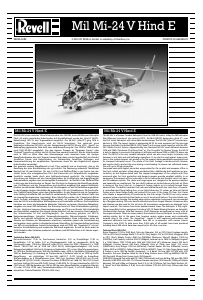

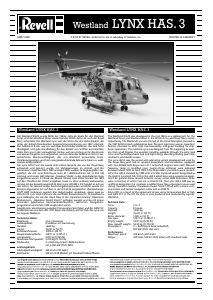
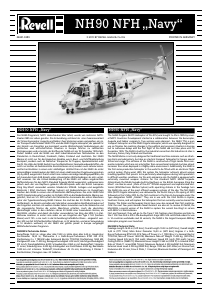
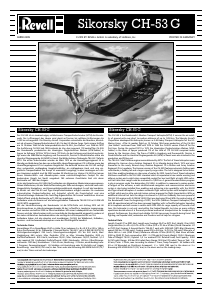
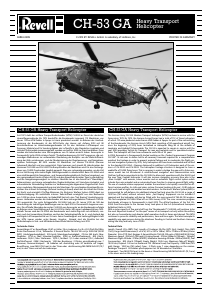
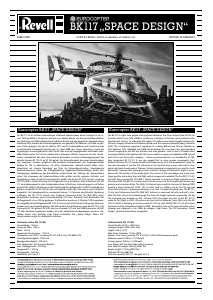
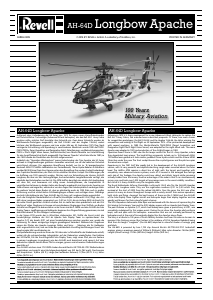

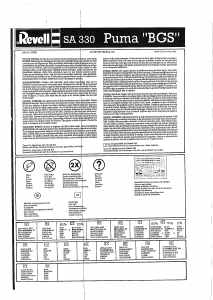
Dołącz do dyskusji na temat tego produktu
Tutaj możesz podzielić się swoją opinią na temat Revell set 04839 Helicopters Mil Mi-24V Hind E. Jeśli masz pytanie, najpierw dokładnie przeczytaj instrukcję. Zapytanie o instrukcję można złożyć za pomocą naszego formularza kontaktowego.